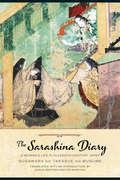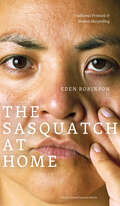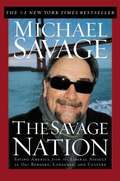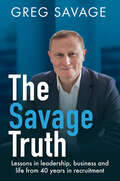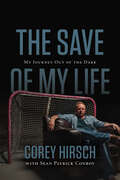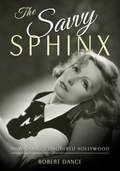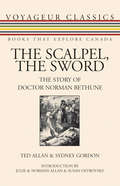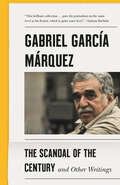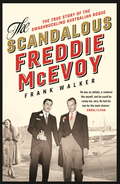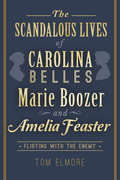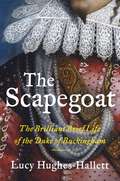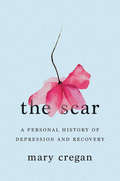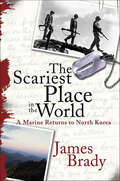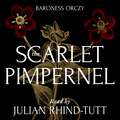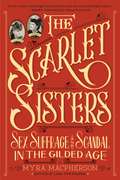- Table View
- List View
The Sarah Siddons Audio Files: Romanticism and the Lost Voice
by Judith Pascoe“The theatre scholar’s daunting but irresistible quest to recover some echoes of performance of the past has never been more engagingly presented than in Pascoe’s account of tracing the long-silenced voice of Sarah Siddons. Her report is a warm, witty, and highly informative exploration of the methodology and the pleasures of historical research. ” —Marvin Carlson, author of The Haunted Stage: The Theatre as Memory Machine During her lifetime (1755–1831), English actress Sarah Siddons was an international celebrity acclaimed for her performances of tragic heroines. We know what she looked like—an endless number of artists asked her to sit for portraits and sculptures—but what of her famous voice, reported to cause audiences to hyperventilate or faint? In The Sarah Siddons Audio Files, Judith Pascoe takes readers on a journey to discover how the actor’s voice actually sounded. In lively and engaging prose, Pascoe retraces her quixotic search, which leads her to enroll in a “Voice for Actors” class, to collect Lady Macbeth voice prints, and to listen more carefully to the soundscape of her life. Bringing together archival discoveries, sound recording history, and media theory, Pascoe shows how romantic poets’ preoccupation with voices is linked to a larger cultural anxiety about the voice’s ephemerality. The Sarah Siddons Audio Files contributes to a growing body of work on the fascinating history of sound and will engage a broad audience interested in how recording technology has altered human experience.
The Sarashina Diary: A Woman's Life in Eleventh-Century Japan (Reader's Edition) (Translations from the Asian Classics)
by Sugawara no Sugawara no Takasue no MusumeA thousand years ago, a young Japanese girl embarked on a journey from deep in the countryside of eastern Japan to the capital. Forty years later, with the long account of that journey as a foundation, the mature woman skillfully created an autobiography that incorporates many moments of heightened awareness from her long life. Married at age thirty-three, she identified herself as a reader and writer more than as a wife and mother; enthralled by fiction, she bore witness to the dangers of romantic fantasy as well as the enduring consolation of self-expression.This reader’s edition streamlines Sonja Arntzen and Moriyuki Itō’s acclaimed translation of the Sarashina Diary for general readers and classroom use. This translation captures the lyrical richness of the original text while revealing its subtle structure and ironic meaning, highlighting the author’s deep concern for Buddhist belief and practice and the juxtaposition of poetic passages and narrative prose. The translators’ commentary offers insight into the author’s family and world, as well as the style, structure, and textual history of her work.
The Sarashina Diary: A Woman's Life in Eleventh-Century Japan (Translations from the Asian Classics)
by Sugawara no Sugawara no Takasue no MusumeA thousand years ago, a young Japanese girl embarked on a journey from the wild East Country to the capital. She began a diary that she would continue to write for the next forty years and compile later in life, bringing lasting prestige to her family. Some aspects of the author's life and text seem curiously modern. She married at age thirty-three and identified herself as a reader and writer more than as a wife and mother. Enthralled by romantic fiction, she wrote extensively about the disillusioning blows that reality can deal to fantasy. The Sarashina Diary is a portrait of the writer as reader and an exploration of the power of reading to shape one's expectations and aspirations. As a person and an author, this writer presages the medieval era in Japan with her deep concern for Buddhist belief and practice. Her narrative's main thread follows a trajectory from youthful infatuation with romantic fantasy to the disillusionment of age and concern for the afterlife; yet, at the same time, many passages erase the dichotomy between literary illusion and spiritual truth. This new translation captures the lyrical richness of the original text while revealing its subtle structure and ironic meaning. The introduction highlights the poetry in the Sarashina Diary and the juxtaposition of poetic passages and narrative prose, which brings meta-meanings into play. The translators' commentary offers insight into the author's family and world, as well as the fascinating textual legacy of her work.
The Sasquatch at Home: Traditional Protocols & Modern Storytelling (The Henry Kreisel Memorial Lecture Series)
by Eden RobinsonThe award-winning Indigenous author of Monkey Beach shares tales from her family, her life, and her culture.In March 2010 the Canadian Literature Centre hosted award-winning novelist and storyteller Eden Robinson at the 4th annual Henry Kreisel Lecture. Robinson shared an intimate look into the intricacies of family, culture, and place through her talk, “The Sasquatch at Home.” Robinson’s disarming honesty and wry irony shine through her depictions of her and her mother’s trip to Graceland, the Potlatch where she and her sister received their Indian names, how her parents first met in Bella Bella (Waglisla, British Columbia) and a wilderness outing where she and her father try to get a look at b’gwus, the Sasquatch. Readers of memoir; Indigenous literatures, histories and cultures; and fans of Robinson’s delightful, poignant, sometimes quirky tales will love The Sasquatch at Home.“[Robinson] strikes sweetly at the commonality of people rather than narrowing in on cultural differences. The entire book is fast, colloquial, and engaging; concise enough to be read in one sitting, yet retaining the weightiness of a larger work. Its brevity makes it an ideal re-read and the second reading proves just as entertaining. The funny parts remain funny, the rendering of landscapes evocative and intimate, and the general themes stay relevant. Through rich and often comic dialogue and her painterly descriptions of the northwest landscape, Eden Robinson presents a glimpse into her community with the delicious, whispered quality of a well-told, yet well-protected, family story.” —Cara-Lyn Morgan, The Malahat Review, Winter 2011“Offers the reader a taste of her skill as a storyteller. The book is a tiny gem. . . . This brilliant little jewel, under fifty pages, offers readers a quick, but intense opportunity to experience the work of a rising Canadian writer. Like her novel, Monkey Beach, the accessibility of The Sasquatch at Home suggests its appropriateness for use in undergraduate courses. Above all, it is an essential acquisition for anyone with an interest in Pacific Northwest or Native Canadian studies, but it is also a find for those who just like a good story.” —Amy J. Ransom, American Review of Canadian Studies
The Sassoons: The Great Global Merchants and the Making of an Empire
by Joseph SassoonA spectacular generational saga of the making (and undoing) of a family dynasty: the riveting untold story of the gilded Jewish Bagdadi Sassoons, who built a vast empire through global finance and trade—cotton, opium, shipping, banking—that reached across three continents and ultimately changed the destinies of nations. With full access to rare family photographs and archives.&“Engaging...compelling...well-paced and supremely satisfying. &”—The New York TimesThey were one of the richest families in the world for two hundred years, from the 19th century to the 20th, and were known as &‘the Rothschilds of the East.&’Mesopotamian in origin, and for more than forty years the chief treasurers to the pashas of Baghdad and Basra, they were forced to flee to Bushir on the Persian Gulf; David Sassoon and sons starting over with nothing, and beginning to trade in India in cotton and opium.The Sassoons soon were building textile mills and factories, and setting up branches in shipping in China, and expanding beyond, to Japan, and further west, to Paris and London. They became members of British parliament; were knighted; and owned and edited Britain&’s leading newspapers, including The Sunday Times and The Observer.And in 1887, the exalted dynasty of Sassoon joined forces with the banking empire of Rothschild and were soon joined by marriage, fusing together two of the biggest Jewish commerce and banking families in the world.Against the monumental canvas of two centuries of the Ottoman Empire and the changing face of the Far East, across Europe and Great Britain during the time of its farthest reach, Joseph Sassoon gives us a riveting generational saga of the making of this magnificent family dynasty.
The Satan-Seller
by Mike Warnke Les Jones Dave BalsigerMike Warnke describes his experiences as a Satanist high priest and conversion to Christianity.
The Savage My Kinsman
by Elisabeth ElliotIn January of 1956, the world recoiled in shock with the news. Five American missionaries had been speared to death in the Equadorian jungles by Auca Indians - reportedly the most savage tribe on earth. Years later, it became clear that what had seemed to be the tragic ending of those missionaries' dreams was only the first chapter of one of the most breathtaking missionary stories of the twentieth century. The Savage, story, in text Elisabeth Elliot's territory, tells of her interactions with the Aucas after her husband's death. She learns their language and culture and teaches them about God.
The Savage Nation, Saving America From The Liberal Assault On Our Borders, Language And Culture
by Michael SavageStraight-talking radio personality, Dr. Michael Savage brings his radio message of borders, language and culture to hardcover in this fast-paced, well-outlined attack on the liberal ethos he blames for a declining America, Savage points out how the ACLU and other liberal groups are the new Communists intent on destroying our constitutional republic with their unmitigated assault on our national borders, English language and Judeo-Christian, Western culture. No matter what you believe, you will enjoy this well-written story of an immigrant's son and his thoughts on America and our future.
The Savage Truth: Lessons in leadership, business and life from 40 years in recruitment
by Greg SavageThe Savage Truth is the story of Greg Savage, his stellar career in recruitment and the lessons he has learned on leadership, business and life over a career spanning four decades.The Savage Truth is a must-read for next generation leaders and lovers of business biography. It is a book in two parts. The first part covers Greg's early life - the people and events that shaped him - and follows his career path, which took him from his hometown of Cape Town around the world before settling in Sydney, Australia. He gives an honest, open, often humorous account of his experiences, which reflect how much business has changed over the past 40 years. In the second part of the book, Greg distils his learnings into guidance and advice for his successors in the recruitment industry and, more broadly, to anyone working in business. He covers topics including building a personal brand, negotiating fees and margins, people leverage, performance management, 'Savage' leadership skills and preparing for exit towards the end of your career.Throughout his fascinating career, Greg has learned countless lessons in leadership, business and in life. One of his greatest achievements is his success as a communicator. Greg is one of the most highly respected voices across the global recruitment and professional services industries, speaking regularly to audiences around the world. An early adopter of social media for recruiters, Greg's industry blog, The Savage Truth (gregsavage.com.au/the-savage-truth), is a must-read in the recruitment industry. In November 2018, he was named one of LinkedIn's 'Top Voices'.
The Save of My Life: My Journey Out of the Dark
by Corey Hirsch Sean Patrick ConboyA riveting look behind the mask of an NHL goalie, The Save of My Life offers understanding and hope to anyone living with mental illnessBy the time he was twenty-two years old, goaltender Corey Hirsch had realized his childhood dream of playing in the NHL, won an Olympic medal and drunk from the Stanley Cup. While he excelled on the ice, out of the net Hirsch was plagued by persistent dark thoughts and ceaseless anxiety. On days when he could barely get out of bed, he was able to push aside the endless loop of dark thoughts running inside his brain long enough to win a game. But as soon as he got back home, the agonizing cycle started all over again. And it continued, until finally he was able to confide in a team trainer who helped him get the professional treatment he needed. Diagnosed with obsessive-compulsive disorder, Hirsch was able to embark on the rocky road to recovery. As one of the first professional athletes to talk openly about mental health, Hirsch wrote about his OCD for the Players’ Tribune. His piece remains one of their most-read articles ever.As Hirsch says, “I am not insane. I am not a bad person. I am not weak. I have an illness, and there is a treatment.”
The Savvy Sphinx: How Garbo Conquered Hollywood
by Robert DanceNamed a 2022 Richard Wall Award Finalist by the Theatre Library AssociationFrom the late 1920s through the thirties, Greta Garbo (1905–1990) was the biggest star in Hollywood. She stopped making films in 1941, at only thirty-six, and thereafter sought a discreet private life. Still, her fame only increased as the public and press clamored for news of the former actress. At the time of her death, forty-nine years later, photographers continued to stalk her, and her death was reported on the front pages of newspapers worldwide. In The Savvy Sphinx: How Garbo Conquered Hollywood, Robert Dance traces the strategy a working-class Swedish teenager employed to enter motion pictures, find her way to America, and ultimately become Hollywood’s most glorious product. Brilliant tactics allowed her to reach Hollywood’s upper-most echelon and made her one of the last century’s most famous people. Garbo was discovered by director Mauritz Stiller, who saw promise in her nascent talent and insisted that she accompany him when he was lured to America by an MGM contract. By twenty she was a movie star and the epitome of glamour. Soon Garbo was among the highest-paid performers, and in many years she occupied the number one position. Unique among studio players, she quickly insisted on and was granted final authority over her scripts, costars, and directors. But Garbo never played the Hollywood game, and by the late twenties her unwillingness to grant interviews, attend premieres, or meet visiting dignitaries won her the sobriquet the Swedish Sphinx. The Savvy Sphinx, which includes over a hundred beautiful images, charts her rise and her long self-imposed exile as the queen who abdicated her Hollywood throne. Garbo was the paramount star produced by the Hollywood studio system, and by the time of her death her legendary status was assured.
The Scalpel and the Silver Bear
by Lori Arviso Alvord Elizabeth Cohen Van PeltA Navajo woman shares her life story and describes how she became a doctor. She blends a belief in modern medicine with ancient Native American beliefs and uses this combination in her practice.
The Scalpel, the Sword: The Story of Doctor Norman Bethune
by Julie Allan Ted Allan Norman Bethune Allan Susan Ostrovsky Sydney GordonOriginally published in the early 1950s, The Scalpel, the Sword celebrates the turbulent career of Dr. Norman Bethune (1890-1939), a brilliant surgeon, campaigner against private medicine, communist, and graphic artist. Bethune belonged to that international contingent of individuals who recognized the threat of fascism in the world and went out courageously to try to defeat it. Born in Gravenhurst, Ontario, Bethune introduced innovative techniques in treating battlefield injuries and pioneered the use of blood transfusions to save lives, which made him a legend first in Spain during the civil war and later in China when he served with the armies of Mao Zedong in their fight against the invading Japanese. He is today remembered amongst the pantheon of Chinese revolutionary heroes. In Canada Bethune’s strong left-wing views made him persona non grata, but this highly readable and engaging account has helped to sustain the memory of a great man.
The Scandal of the Century: And Other Writings (Vintage International Ser.)
by Gabriel García Márquez“The articles and columns in The Scandal of the Century demonstrate that his forthright, lightly ironical voice just seemed to be there, right from the start. . . . He’s among those rare great fiction writers whose ancillary work is almost always worth finding. . . . He had a way of connecting the souls in all his writing, fiction and nonfiction, to the melancholy static of the universe.” --Dwight Garner, The New York TimesFrom one of the titans of twentieth-century literature, collected here for the first time: a selection of his journalism from the late 1940s to the mid-1980s--work that he considered even more important to his legacy than his universally acclaimed works of fiction. "I don't want to be remembered for One Hundred Years of Solitude or for the Nobel Prize but rather for my journalism," Gabriel García Márquez said in the final years of his life. And while some of his journalistic writings have been made available over the years, this is the first volume to gather a representative selection from across the first four decades of his career--years during which he worked as a full-time, often muckraking, and controversial journalist, even as he penned the fiction that would bring him the Nobel Prize in 1982. Here are the first pieces he wrote while working for newspapers in the coastal Colombian cities of Cartagena and Barranquilla . . . his longer, more fictionlike reportage from Paris and Rome . . . his monthly columns for Spain's El País. And while all the work points in style, wit, depth, and passion to his fiction, these fifty pieces are, more than anything, a revelation of the writer working at the profession he believed to be "the best in the world."
The Scandalous Freddie McEvoy: The true story of the swashbuckling Australian rogue
by Frank WalkerSwashbuckler, daredevil racing-car champion, Winter Olympian, gambler, smuggler, scoundrel, stud and suspected Nazi agent who died a mysterious death - this is the fascinating story of the scandalous Freddie McEvoy.Born in Melbourne in 1907, Freddie's life took him from socialising with a young Errol Flynn in Sydney and on to the French Riviera in the heady years leading up to World War II. With his dashing good looks and charm, Freddie lived a swashbuckling life, quickly figuring out his path to easy fortune was through lonely rich women. World War II didn't stop Freddie's hedonistic pursuits - he skipped enlistment for Australia and Britain to party on in Hollywood, where he renewed his friendship with the now infamous Errol Flynn. Always short of cash, Freddie smuggled guns and diamonds on his yacht between California and Mexico and was rumoured to have worked as a spy. It was a life lived large and Freddie's death in 1951 was under the most mysterious circumstances off the coast of Morocco: his body was found naked and scalped . . .Frank Walker, bestselling author of The Tiger Man of Vietnam and Maralinga, has for the first time uncovered the complete, outrageous and incredible true story of Freddie McEvoy, Australia's daredevil lothario.'Freddie was one of the great livers of life. He lived it the way he saw it - he didn't give a hoot.'Errol Flynn'Pleasure is my business.' Freddie McEvoy'an extraordinary yarn . . . finely researched' Sun-Herald on Frank Walker's Ghost Platoon
The Scandalous Hamiltons: A Gilded Age Grifter, a Founding Father's Disgraced Descendant, and a Trial at the Dawn of Tabloid Journalism
by Bill ShafferOne of the country&’s most powerful families embroiled in sex, lies, bigamy, and blackmail . . . and every new, deliciously humiliating morsel splashed across every newspaper in America Now in paperback, the believe-it-or-not historical true crime behind one of the greatest scandals of the Gilded Age, and the story that gave rise to the sensational tabloid journalism still driving so much of the news cycle in the 21st century.An Alexander Hamilton heir, a beautiful female con artist, an abandoned baby, and the shocking courtroom drama that was splashed across front pages from coast to coast . . . It&’s a historical true crime story almost too tawdry to be true—a con woman met the descendant of a Founding Father in a brothel, duped him into marriage using an infant purchased from a baby farm, then went to prison for stabbing the couple&’s baby nurse—all while in a common-law marriage with another man. The scandal surrounding Evangeline and Robert Ray Hamilton was one of the sensations of the Gilded Age, a sordid, gripping tale involving bigamy, bribery, sex, and violence. Through personal correspondence, court records, and sensational newspaper accounts, The Scandalous Hamiltons explores not only the full, riveting saga of ill-fated Ray and Eva, but the rise of tabloid journalism—including an exclusive interview conducted by world-famous investigative reporter Nellie Bly—in a story that unfurls as a timeless tale of ambition, greed, and obsession.&“Fans of Erik Larson–style histories and anyone who just loves a fun, gossipy read will love The Scandalous Hamiltons.&” —Apple Books, Best of the Month Selection"Adultery? Check. Attempted murder? Check. Baby-trafficking? Check. These are just a few of the missteps of the woman who rained humiliation onto the House of Hamilton." —Marlene Wagman-Geller, author of Women of Means: Fascinating Biographies of Royals, Heiresses, Eccentrics and Other Poor Little Rich Girls
The Scandalous Lives of Carolina Belles Marie Boozer and Amelia Feaster: Flirting with the Enemy
by Tom ElmoreA look into the lives of a Civil War-era mother and daughter whose exploits were tabloid fodder and worthy of a reality show.In Civil War Columbia, South Carolina, no women were more gossiped about than Amelia Feaster and her teenage daughter, Marie Boozer. The Philadelphia-born Feaster, a widow three times before her thirty-first birthday, aided the Union war effort from her home, while Marie became infamous for her beauty and vanity. For over a century, scandalous tales of these women have been published across the nation, linking them to rich and powerful men both at home and abroad. Historian Tom Elmore sorts through the many myths and legends—involving such things as adultery, decapitation and the Russian tsar’s jewels—about Feaster and Boozer to present the first fact-based biography of these two nineteenth-century tabloid queens.
The Scapegoat: The Brilliant Brief Life of the Duke of Buckingham
by Lucy Hughes-HallettShortlisted for the Pol Roger Duff Cooper PrizeFrom the winner of the Baillie Gifford Prize, an extraordinary history of the meteoric rise and fall of George Villiers, the first Duke of Buckingham.As King James I’s favorite, Buckingham was also his confidant, gatekeeper, advisor and lover. When Charles I succeeded his father, he was similarly enthralled and made Buckingham his best friend and mentor. A dazzling figure on horseback and a skillful player of the political game, Buckingham rapidly transformed the influence his beauty gave him into immense wealth and power. He became one of the most flamboyant and enigmatic Englishmen at the heart of seventeenth-century royal and political life.With a novelist’s touch, Lucy Hughes-Hallett transports us into a courtly world of masques and dancing, exquisite clothes, the art of Rubens and Van Dyck, gender-fluidity, same-sex desire, and appallingly rudimentary medicine. Witch hunts coexisted with Descartian rationality and public opinion was becoming a political force. Falling from grace spectacularly, Buckingham came to represent everything that was wrong with the country.From kidnappings and murder plots to men weeping in Parliament over civil liberties, The Scapegoat navigates love, war-fever and pacifism in a society on the brink of cataclysmic change. In this immersive and authoritative account, Hughes-Hallett summons an era that still resonates today.
The Scar: A Personal History Of Depression And Recovery
by Mary CreganA graceful and penetrating memoir interweaving the author’s descent into depression with a medical and cultural history of this illness. At the age of twenty-seven, married, living in New York, and working in book design, Mary Cregan gives birth to her first child, a daughter she names Anna. But it’s apparent that something is terribly wrong, and two days later, Anna dies—plunging Cregan into suicidal despair. Decades later, sustained by her work, a second marriage, and a son, Cregan reflects on this pivotal experience and attempts to make sense of it. She weaves together literature and research with details from her own ordeal—and the still visible scar of her suicide attempt—while also considering her life as part of the larger history of our understanding of depression. In fearless, candid prose, Cregan examines her psychotherapy alongside early treatments of melancholia, weighs the benefits of shock treatment against its terrifying pop culture depictions, explores the controversy around antidepressants and how little we know about them—even as she acknowledges that the medication saved her life—and sifts through the history of the hospital where her recovery began. Perceptive, intimate, and elegantly written, The Scar vividly depicts the pain and ongoing stigma of clinical depression, giving greater insight into its management and offering hope for those who are suffering.
The Scariest Place in the World: A Marine Returns to North Korea
by James BradyA memoir from the New York Times bestselling author of Warning of War and Marines of Autumn, James Brady's The Scariest Place in the World. Half a century after he fought there as a young lieutenant of Marines, James Brady returns to the brooding Korean ridgelines and mountains to sound taps for a generation. It's been years since Brady first wrote of Korea in The Coldest War, drawing raves from Walter Cronkite and The New York Times, which called it "a superb personal memoir of the way it was." In the spring of 2003, Brady and Pulitzer Prize–winning combat photographer Eddie Adams flew in Black Hawk choppers and trekked the Demilitarized Zone where it meanders into North Korea, interviewing four-star generals and bunking in with tough U.S. recon troops, in Brady's words, "raw meat on the point of a sharpened stick." Brady recalls that first time on bloody Hill 749, the men who died there, what happened to the Marines who lived to make it home, and experiences yet again the emotional pull of a lifelong love affair with the Corps in which they all served. Brady summons up the past and illuminates the present, be it the Korea of "the forgotten war," the Yanks who fought there long ago, or today's soldiers standing wary sentinel over "the scariest place in the world." The result is uplifting, inspiring, often heartbreaking, and this Brady memoir proves as powerful as his first.
The Scarlet Letter: The Original 1850 Edition (Nathaniel Hawthorne Classics)
by Nathaniel Hawthorne“No man, for any considerable period, can wear one face to himself and another to the multitude, without finally getting bewildered as to which may be the true.” ― Nathaniel Hawthorne, The Scarlet Letter The Scarlet Letter: A Romance is a work of historical fiction by American author Nathaniel Hawthorne, published in 1850. Set in Puritan Massachusetts Bay Colony during the years 1642 to 1649, the novel tells the story of Hester Prynne, who conceives a daughter through an affair and then struggles to create a new life of repentance and dignity. Containing a number of religious and historic allusions, the book explores themes of legalism, sin, and guilt.
The Scarlet Pimpernel
by Baroness OrczyA brand new, unabridged recording of Baroness Orczy's classic tale of adventure, read by Julian Rhind-Tutt.Paris, 1792. The Terror has begun. Every day, scores of the French nobility are delivered to the guillotine. Trapped in the capital, they have no way of escape. But rumours abound of a league of young English gentlemen who are risking their lives to spirit French aristocrats away to safety across the Channel. Led by a man known only as the 'Scarlet Pimpernel', they leave no trace behind them save a single note. Determined to stop them, ruthless spymaster Chauvelin travels to England and embarks on a quest to uncover the identity of their leader, forcing the Scarlet Pimpernel and his men to summon all their courage and wits to evade capture and stay alive. (P)2018 Hodder & Stoughton Limited
The Scarlet Professor: A Literary Life Shattered by Scandal
by Barry WerthStory of a literary critic destroyed by inuendo.
The Scarlet Sisters: My nanna’s story of secrets and heartache on the banks of the River Thames
by Helen Batten‘Oh my goodness – another girl Mrs Swain!’ Clara’s normal iron composure broke and she screamed, ‘No! That’s not the bloody deal!’And that is how my nanna, Bertha Swain, entered the world.When Helen Batten’s marriage breaks down, she starts on a journey of discovery into her family’s past and the mysteries surrounding her enigmatic nanna’s early life. What she unearths is a tale of five feisty red heads struggling to climb out of poverty and find love through two world wars. It’s a story full of surprises and scandal – a death in a workhouse, a son kept in a box, a shameful war record, a clandestine marriage and children taken far too soon. It’s as if there is a family curse. But Helen also finds love, resilience and hope – crazy wagers, late night Charlestons and stolen kisses. As she unravels the story of Nanna and her scarlet sisters, Helen starts to break the spell of the past, and sees a way she might herself find love again.
The Scarlet Sisters: Sex, Suffrage, and Scandal in the Gilded Age
by Myra MacphersonA fresh look at the life and times of Victoria Woodhull and Tennie Claflin, two sisters whose radical views on sex, love, politics, and business threatened the white male power structure of the nineteenth century and shocked the world. Victoria Woodhull and Tennessee "Tennie" Claflin-the most fascinating and scandalous sisters in American history-were unequaled for their vastly avant-garde crusade for women's fiscal, political, and sexual independence. They escaped a tawdry childhood to become rich and famous, achieving a stunning list of firsts. In 1870 they became the first women to open a brokerage firm, not to be repeated for nearly a century. Amid high gossip that he was Tennie's lover, the richest man in America, fabled tycoon Cornelius Vanderbilt, bankrolled the sisters. As beautiful as they were audacious, the sisters drew a crowd of more than two thousand Wall Street bankers on opening day. A half century before women could vote, Victoria used her Wall Street fame to become the first woman to run for president, choosing former slave Frederick Douglass as her running mate. She was also the first woman to address a United States congressional committee. Tennie ran for Congress and shocked the world by becoming the honorary colonel of a black regiment. They were the first female publishers of a radical weekly, and the first to print Karl Marx's Communist Manifesto in America. As free lovers they railed against Victorian hypocrisy and exposed the alleged adultery of Henry Ward Beecher, the most famous preacher in America, igniting the "Trial of the Century" that rivaled the Civil War for media coverage. Eventually banished from the women's movement while imprisoned for allegedly sending "obscenity" through the mail, the sisters sashayed to London and married two of the richest men in England, dining with royalty while pushing for women's rights well into the twentieth century. Vividly telling their story, Myra MacPherson brings these inspiring and outrageous sisters brilliantly to life. She deconstructs and lays bare the manners and mores of Victorian America, remarkably illuminating the struggle for equality that women are still fighting today.


